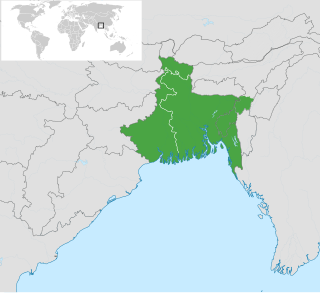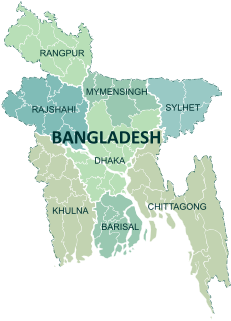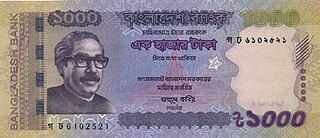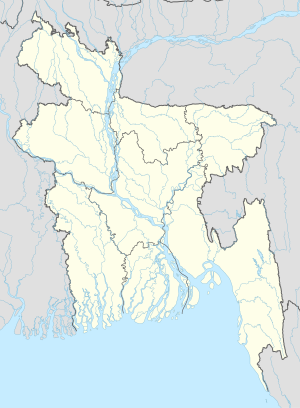
Bengal is a geopolitical, cultural and historical region in South Asia, specifically in the eastern part of the Indian subcontinent at the apex of the Bay of Bengal. Geographically, it is made up by the Ganges-Brahmaputra delta system, the largest such formation in the world; along with mountains in its north bordering the Himalayan states of Nepal and Bhutan and east bordering Burma.

Dhaka, formerly known as Dacca, is the capital and largest city of Bangladesh. It is one of the largest and most densely populated cities in the world, with a population of 18.89 million people in the Greater Dhaka Area. Dhaka is the economic, political and cultural center of Bangladesh. It is one of the major cities of South Asia, the largest city in Eastern South Asia and among the Bay of Bengal countries; and one of the largest cities among OIC countries. As part of the Bengal plain, the city is bounded by the Buriganga River, Turag River, Dhaleshwari River and Shitalakshya River. The city is located in an eponymous district and division.

The market-based economy of Bangladesh is the 42nd largest in the world in nominal terms, and 31st largest by purchasing power parity; it is classified among the Next Eleven emerging market middle income economies and a Frontier market. According to the IMF, Bangladesh's economy is the second fastest growing major economy of 2016, with a rate of 7.1%. Dhaka and Chittagong are the principal financial centers of the country, being home to the Dhaka Stock Exchange and the Chittagong Stock Exchange. The financial sector of Bangladesh is the second largest in the subcontinent.

The administration of Bangladesh is divided into eight major regions called divisions. Each division is named after the major city within its jurisdiction that also serves as the administrative headquarters of that division. Each division is further split into several districts which are then further sub-divided into Upazilas.

The Bangladesh Air Force, is the aerial warfare branch of the Bangladesh Armed Forces, primarily tasked with the air defence of Bangladesh territory and providing air support to the Bangladesh Army and Navy. Additionally, the service has a territorial role of providing strategic air transport and logistics capability for the country.

Chittagong, officially known as Chattogram, is a major coastal city and financial centre in southeastern Bangladesh. The city has a population of more than 2.5 million while the metropolitan area had a population of 4,009,423 in 2011, making it the second-largest city in the country. It is the capital of an eponymous District and Division. The city is located on the banks of the Karnaphuli River between the Chittagong Hill Tracts and the Bay of Bengal.

The Bangladeshi taka is the currency of the People's Republic of Bangladesh. Issuance of banknotes ৳10 and larger is controlled by Bangladesh Bank, and for the ৳2 and ৳5 banknotes, which are the responsibility of the Ministry of Finance of the government of Bangladesh. The most commonly used symbol for the taka is "৳" and "Tk", used on receipts while purchasing goods and services. ৳1 is subdivided into 100 poisha.

The Jatiya Sangsad, often referred to simply as the Sangsad or JS and also known as the House of the Nation, is the supreme legislative body of Bangladesh. The current parliament of Bangladesh contains 350 seats, including 50 seats reserved for women, which are apportioned on elected party position in the parliament. Elected occupants are called members of parliament or MP. The 11th National Parliamentary Election was held on 30 December 2018. Elections are held every five years unless the parliament is dissolved before that time.

Sheikh Hasina Wazed is a Bangladeshi politician serving as the 10th Prime Minister of Bangladesh, having held the office since January 2009. She is the longest serving prime minister in the history of Bangladesh.

The Bangladesh Liberation War, also known as the Bangladesh War of Independence, or simply the Liberation War in Bangladesh, was a revolution and armed conflict sparked by the rise of the Bengali nationalist and self-determination movement in what was then East Pakistan during the 1971 Bangladesh genocide. It resulted in the independence of the People's Republic of Bangladesh. The war began after the Pakistani military junta based in West Pakistan launched Operation Searchlight against the people of East Pakistan on the night of 25 March 1971. It pursued the systematic elimination of nationalist Bengali civilians, students, intelligentsia, religious minorities and armed personnel. The junta annulled the results of the 1970 elections and arrested Prime minister-designate Sheikh Mujibur Rahman. The war ended on 16 December 1971 after West Pakistan surrendered.

The Bangladesh national cricket team, is administered by the Bangladesh Cricket Board (BCB). Bangladesh is a full member of the International Cricket Council (ICC) with Test and One Day International (ODI) status. It played its first Test match in November 2000 against India in Dhaka, becoming the tenth Test-playing nation.

The Bangladesh Army is the land forces branch and the largest of the three defence service of the Bangladesh Armed Forces. The primary mission of the Army is to provide necessary forces and capabilities in support of Bangladesh's security and defence strategies including defence of the nation's territorial integrity against external attack. Control and operations are administered by the Department of the Army of the Armed Forces Division. In addition to its primary mission the Bangladesh Army is also constitutionally obligated to assist the civilian government during times of national emergency. This role is commonly referred to as "aid to civil administration".

Bengalis, also rendered as the Bengali people, Bangalis and Bangalees, are an Indo-Aryan ethnic group native to the Bengal region in South Asia, specifically in the eastern part of the Indian subcontinent, presently divided between Bangladesh and the Indian states of West Bengal, Tripura, Assam's Barak Valley, who speak Bengali, a language from the Indo-Aryan language family. The term "Bangalee" is also used to denote people of Bangladesh as a nation.

Upazila, formerly called thana, is an administrative region in Bangladesh. They function as sub-units of districts. Their functionality can be seen to be analogous to that of a county or a borough of Western countries.

Bengali, also known by its endonym Bangla, is an Indo-Aryan language primarily spoken by the Bengalis in South Asia. It is the official and most widely spoken language of Bangladesh and second most widely spoken of the 22 scheduled languages of India, behind Hindi. In 2015, 160 million speakers were reported for Bangladesh, and the 2011 Indian census counted another 100 million.

Bangladeshis are the citizens of Bangladesh. The country is named after the historical region of Bengal, of which it constitutes the largest and easternmost part. Bangladeshi citizenship was formed in 1971, when the permanent residents of the former East Pakistan were transformed into citizens of a new republic. Bangladesh is the world's eighth most populous nation. Vast majority of Bangladeshis are ethnolingustically Asian Indo-Aryan people who speak Bengali language and follow the Islamic religion. The population of Bangladesh is concentrated in the fertile Bengal delta, which has been the center of urban and agrarian civilizations for millennia. The country's highlands, including the Chittagong Hill Tracts and the Sylhet Division, are home to various tribal minorities.
Climate change in Bangladesh is a pressing issue. According to National Geographic, Bangladesh is one the most vulnerable nations to the impacts of climate change. Bangladesh being located on the Tropic of Cancer receives fairly direct radiation throughout the year & maintains relatively high temperature.

The divisions of Bangladesh are divided into 64 districts, or zila. The capital of a district is called a district seat. The districts are further subdivided into 493 sub-districts or upazila.


















